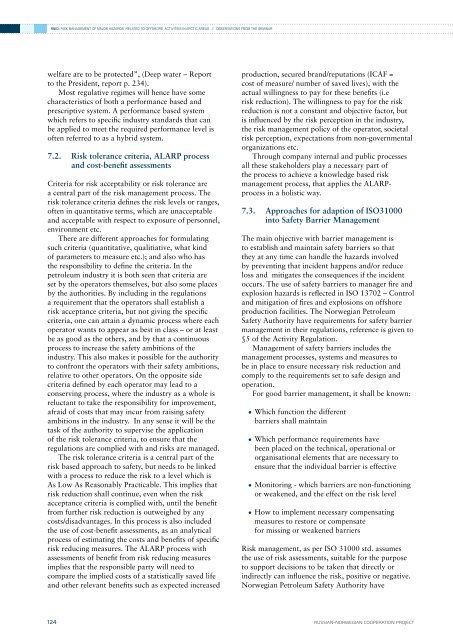phase 4 report - DNV
phase 4 report - DNV
phase 4 report - DNV
You also want an ePaper? Increase the reach of your titles
YUMPU automatically turns print PDFs into web optimized ePapers that Google loves.
RN03: RISK MANAGEMENT OF MAJOR HAZARDS RELATED TO OFFSHORE ACTIVITIES IN ARCTIC AREAS // observations from the seminarwelfare are to be protected”, (Deep water – Reportto the President, <strong>report</strong> p. 234).Most regulative regimes will hence have somecharacteristics of both a performance based andprescriptive system. A performance based systemwhich refers to specific industry standards that canbe applied to meet the required performance level isoften referred to as a hybrid system.7.2. Risk tolerance criteria, ALARP processand cost-benefit assessmentsCriteria for risk acceptability or risk tolerance area central part of the risk management process. Therisk tolerance criteria defines the risk levels or ranges,often in quantitative terms, which are unacceptableand acceptable with respect to exposure of personnel,environment etc.There are different approaches for formulatingsuch criteria (quantitative, qualitiative, what kindof parameters to measure etc.); and also who hasthe responsibility to define the criteria. In thepetroleum industry it is both seen that criteria areset by the operators themselves, but also some placesby the authorities. By including in the regulationsa requirement that the operators shall establish arisk acceptance criteria, but not giving the specificcriteria, one can attain a dynamic process where eachoperator wants to appear as best in class – or at leastbe as good as the others, and by that a continuousprocess to increase the safety ambitions of theindustry. This also makes it possible for the authorityto confront the operators with their safety ambitions,relative to other operators. On the opposite sidecriteria defined by each operator may lead to aconserving process, where the industry as a whole isreluctant to take the responsibility for improvement,afraid of costs that may incur from raising safetyambitions in the industry. In any sense it will be thetask of the authority to supervise the applicationof the risk tolerance criteria, to ensure that theregulations are complied with and risks are managed.The risk tolerance criteria is a central part of therisk based approach to safety, but needs to be linkedwith a process to reduce the risk to a level which isAs Low As Reasonably Practicable. This implies thatrisk reduction shall continue, even when the riskacceptance criteria is complied with, until the benefitfrom further risk reduction is outweighed by anycosts/disadvantages. In this process is also includedthe use of cost-benefit assessments, as an analyticalprocess of estimating the costs and benefits of specificrisk reducing measures. The ALARP process withassessments of benefit from risk reducing measuresimplies that the responsible party will need tocompare the implied costs of a statistically saved lifeand other relevant benefits such as expected increasedproduction, secured brand/reputations (ICAF =cost of measure/ number of saved lives), with theactual willingness to pay for these benefits (i.erisk reduction). The willingness to pay for the riskreduction is not a constant and objective factor, butis influenced by the risk perception in the industry,the risk management policy of the operator, societalrisk perception, expectations from non-governmentalorganizations etc.Through company internal and public processesall these stakeholders play a necessary part ofthe process to achieve a knowledge based riskmanagement process, that applies the ALARPprocessin a holistic way.7.3. Approaches for adaption of ISO31000into Safety Barrier ManagementThe main objective with barrier management isto establish and maintain safety barriers so thatthey at any time can handle the hazards involvedby preventing that incident happens and/or reduceloss and mitigates the consequences if the incidentoccurs. The use of safety barriers to manager fire andexplosion hazards is reflected in ISO 13702 – Controland mitigation of fires and explosions on offshoreproduction facilities. The Norwegian PetroleumSafety Authority have requirements for safety barriermanagement in their regulations, reference is given to§5 of the Activity Regulation.Management of safety barriers includes themanagement processes, systems and measures tobe in place to ensure necessary risk reduction andcomply to the requirements set to safe design andoperation.For good barrier management, it shall be known:• Which function the differentbarriers shall maintain• Which performance requirements havebeen placed on the technical, operational ororganisational elements that are necessary toensure that the individual barrier is effective• Monitoring - which barriers are non-functioningor weakened, and the effect on the risk level• How to implement necessary compensatingmeasures to restore or compensatefor missing or weakened barriersRisk management, as per ISO 31000 std. assumesthe use of risk assessments, suitable for the purposeto support decisions to be taken that directly orindirectly can influence the risk, positive or negative.Norwegian Petroleum Safety Authority have124RUSSIAN–NORWEGIAN COOPERATION PROJECT






![Risk Based Pipeline Integrity Management [Compatibility Mode] - DNV](https://img.yumpu.com/50424229/1/190x146/risk-based-pipeline-integrity-management-compatibility-mode-dnv.jpg?quality=85)









